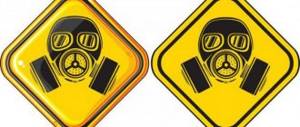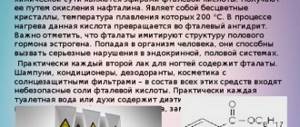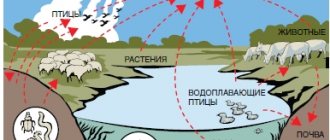Neurotoxin
- a toxin[1] that specifically acts on nerve cells, usually interacting with membrane proteins such as ion channels. Some neurotoxins attack nerve tissue, but, for example, Alpha-bungarotoxin, which is a neurotoxin[2], affects neuromuscular junctions.
Neurotoxins are alcohol, botulinum toxin, poneratoxin, tetrodotoxin, batrachotoxin, components of the venoms of bees, spiders, scorpions, snakes, salamanders.
Potent neurotoxins, such as batrachotoxin, affect the nervous system by depolarizing nerves and muscle fibers, increasing the permeability of the cell membrane to sodium ions.
Many poisons and toxins used by organisms, such as some plants, to protect themselves from vertebrates are neurotoxins. The most common effect of contact is paralysis, which occurs very quickly. Some animals use neurotoxins when hunting, since paralyzed prey becomes convenient prey.
What are neurotoxins and where are toxic substances used?
Neurotoxins can be chemicals, drugs that cause anesthesia, antiseptics, metal fumes, aggressive detergents, pesticides and insecticides. Some living organisms are capable of producing neurotoxins in response to a threat to the immune system, and numerous toxic substances are present in the environment.
According to scientific research data summarized in the publication of the authoritative weekly medical journal “The Lancet,” about two hundred toxins can damage the human nervous system. Later (after studying data from the National Institute of Occupational Safety), it became necessary to add to the published list the same number of toxic substances that in one way or another have a negative effect on the central nervous system.
In the latter case, damage to nerve fibers was combined with damage to associated organs and systems, and symptoms of a neurotoxic disorder appeared when permissible exposure limits were exceeded.
Thus, the list of chemicals that can be classified as neurotoxins expands depending on what criteria a particular publication or author adheres to.
You can get neurotoxin poisoning by inhaling toxic fumes, increasing the permissible concentration in the blood, or eating foods saturated with large amounts of toxic substances. Many toxic substances are present in the environment, consumer goods, and household chemicals. Neurotoxins are used in cosmetology, medicine and industry.
Bacillus anthrax
0
Anthrax is a very serious, rapidly developing disease caused by the bacteria Bacillus anthracis. There are several forms of anthrax. The most “harmless” one is the skin one. Even without treatment, the mortality rate from this form does not exceed 20%. The intestinal form kills about half of those sick, but the pulmonary form is almost certain death. Even with the help of the latest treatment methods, modern doctors manage to save no more than 5% of patients.
What is the neurotoxic effect on the body?
Neurotoxic effects primarily affect the brain and nerve fibers. Neutralization of the work of cells in the nervous system can lead to muscle paralysis, the occurrence of an acute allergic reaction, and affects the general mental state of a person. In severe cases, poisoning can cause coma and be fatal.
Toxic substances of this kind are absorbed into nerve endings, transmitted to cells and disrupt vital functions. The body's natural detoxification mechanisms are practically powerless against neurotoxins: in the liver, for example, the main functional feature of which is the elimination of harmful substances, most neurotoxins, due to their specific nature, are reabsorbed by nerve fibers.
Neurotoxic poison can complicate the course of any disease, which makes definitive diagnosis and timely treatment difficult.
Establishing an accurate diagnosis necessarily includes determining the suspected source of infection, studying the history of contact with a potential poison, identifying the full clinical picture and conducting laboratory tests.
Tetrodotoxin
0
This extremely strong poison is found in the liver, milk and caviar of the famous puffer fish, as well as in the skin and caviar of some species of tropical frogs, octopuses, crabs and in the caviar of the Californian newt. Europeans first became acquainted with the effects of this poison in 1774, when the crew on James Cook's ship ate an unknown tropical fish, and the slops from the dinner were given to the ship's pigs. By morning, all the people were seriously ill, and the pigs died. Tetrodotoxin poisoning is very serious, and even today doctors manage to save less than half of all those poisoned. It is interesting to note that the famous Japanese delicacy fugu fish is prepared from fish in which the content of the most dangerous toxin exceeds lethal doses for humans. Lovers of this treat literally entrust their lives to the art of the cook. But no matter how hard the chefs try, accidents cannot be avoided, and every year several gourmets die after feasting on a delicious dish.
Classification of the most famous representatives of neurotoxins
Medical sources classify neurotoxins into channel inhibitors, nerve agents, and neurotoxic drugs. Based on their origin, toxic substances are divided into those obtained from the external environment (exogenous) and those produced by the body (endogenous).
The classification of neurotoxins, poisoning from which is likely to occur at work and at home, includes three groups of the most common substances:
- Heavy metals. Mercury, cadmium, lead, antimony, bismuth, copper and other substances are quickly absorbed into the digestive tract, carried through the bloodstream to all vital organs and deposited in them.
- Biotoxins. Biotoxins include potent poisons that are produced, in particular, by marine life and spiders. Substances can penetrate mechanically (by a bite or injection) or by eating poisonous animals. In addition, botulism bacteria are biotoxins.
- Xenobiotics. A distinctive feature of this group of neurotoxins is their prolonged effect on the human body: the half-life of dioxin, for example, ranges from 7 to 11 years.
Classification and examples[ | ]
Channel inhibitors[ | ]
Nerve agents[ | ]
- Alkyl derivatives of methylfluorophosphonic acid: DFP, sarin, soman, cyclosarin, ethylzarin.
- Cholinethiophosphonates and cholinephosphonates: V-gases.
- Other similar compounds: herd.
Neurotoxic drugs[ | ]
- Methamphetamine, MDMA[5][6], para-chloramphetamine, nicotine[7]
- Levodopa
- Ketamine, PCP, DXM, dizocilpine (MK-801)
- Sodium hydroxybutyrate[8]
- Ibotenic acid, picrotoxin, bicuculline
Symptoms of neurotoxin damage
Neurotoxic disorders caused by toxic substances are characterized by a number of symptoms typical of poisoning in principle, and specific signs that occur during intoxication with a particular compound.
Heavy metal intoxication
Thus, patients experience the following signs of heavy metal intoxication:
- abdominal discomfort;
- bloating, diarrhea, or constipation;
- nausea and occasional vomiting.
At the same time, poisoning with a specific metal has its own distinctive characteristics. Thus, with mercury intoxication, a metallic taste is felt in the mouth, increased salivation and swelling of the lymph nodes are characteristic, and it is characterized by a strong cough (sometimes with blood), lacrimation, and irritation of the mucous membranes of the respiratory tract.
A severe case is: anemia develops, the skin becomes bluish, and the functioning of the liver and kidneys is quickly disrupted.
Biotoxin poisoning
In case of poisoning with biotoxins, the first signs of intoxication may include:
- increased salivation, numbness of the tongue, loss of sensation in the legs and arms (typical of poisoning with tetrodotoxin contained in puffer fish);
- increasing abdominal pain, nausea and vomiting, bowel irregularities, spots before the eyes and respiratory failure (botulinum toxin intoxication);
- severe pain in the heart, hypoxia, paralysis of internal muscles (a condition similar to a heart attack occurs when poisoned with batrachotoxin contained in the glands of some species of frogs).
Intoxication with xenobiotics
A neurotoxic poison of anthropogenic origin is dangerous because symptoms of intoxication can appear over a long period of time, which leads to chronic poisoning.
Damage from formaldehyde or dioxins - by-products of the production of pesticides, paper, plastics, etc. - is accompanied by the following symptoms:
- loss of strength, fatigue, insomnia;
- abdominal pain, loss of appetite and exhaustion;
- irritation of the mucous membranes of the mouth, eyes and respiratory tract;
- nausea, vomiting blood, diarrhea;
- impaired coordination of movements;
- anxiety, delirium, feeling of fear.
Strychnine
0
Strychnine is found in large quantities in the nuts of the tropical chilibuha tree. It was from them that it was obtained in 1818 by the French chemists Pelletier and Cavantou. In small doses, strychnine can be used as a medicine that increases metabolic processes, improves heart function and treats paralysis. It was even actively used as an antidote for barbiturate poisoning. However, it is one of the most powerful poisons. Its lethal dose is even less than the famous potassium cyanide, but it acts much more slowly. Death from strychnine poisoning occurs after about half an hour of terrible agony and severe convulsions.
Features of neurotoxin poisoning
A distinctive feature of neurotoxins is damage to the human nervous system.
Thus, the patient’s condition is characterized by:
- impaired coordination of movements;
- slowing brain activity;
- disturbances of consciousness, memory loss;
- throbbing headache;
- darkening of the eyes.
As a rule, the general symptoms include symptoms of poisoning from the respiratory, digestive and cardiovascular systems. The specific clinical picture depends on the source of intoxication.
Prevention of intoxication at work and at home
Prevention of poisoning largely depends on the nature of the potential threat. So, in order to avoid intoxication with biotoxins, food should be thoroughly cooked, avoid eating expired or low-quality products, and prevent contact with potentially poisonous animals and plants. Heavy metal poisoning can be prevented by using products made from these materials strictly for their intended purpose, observing safety measures when working in hazardous industries and sanitary rules.
Research shows that autism and other nervous disorders are being diagnosed more and more often today. The reason for this may be not only hereditary genetic diseases, but also dangerous chemicals. In particular, organophosphates alone, used in agriculture, seriously affect the state of the central nervous system.
And recently, experts identified 10 chemicals, so-called neurotoxins, found both in the environment and in household items, furniture and clothing. According to scientists, these substances are the cause of the development of diseases that affect the nervous system. Most of them are already severely limited in use, but some of them still pose a great danger.
Chlorpyrifos
A common chemical in the past, part of the group of organophosphate pesticides, used to kill pests. Currently, chlorpyrifos is classified as a highly toxic compound, hazardous to birds and freshwater fish, and moderately toxic to mammals. Despite this, it is still widely used in non-food crops and for processing wood products.
Methylmercury
Methylmercury is a dangerous neurotoxin that affects the mechanisms of heredity in humans. It causes abnormal mitoses (K-mitoses) in cells and also damages chromosomes, and its effect is 1000 times greater than that of colchicine. Scientists believe it is possible that methylmercury can cause birth defects and mental defects.
Polychlorinated biphenyls
Or PCBs, are part of a group of chemicals defined as persistent organic pollutants. They enter the body through the lungs, gastrointestinal tract with food or skin, and are deposited in fats. PCBs are classified as a probable human carcinogen. In addition, they cause liver disease, disrupt reproductive function and disrupt the endocrine system.
Ethanol
As it turns out, ethanol is not an environmentally friendly alternative to gasoline. According to scientists from Stanford University, cars using a mixture of ethanol and gasoline contribute to an increase in the level of two carcinogens in the atmosphere - formaldehyde and acetaldehyde. In addition, when using ethanol as fuel, the level of atmospheric ozone will increase, which, even at low concentrations, leads to all sorts of lung diseases.
Lead
Penetrating into the body, lead enters the bloodstream, and is partially excreted naturally, and partially deposited in various systems of the body. With a significant degree of intoxication, disturbances in the functional state of the kidneys, brain, and nervous system develop. Poisoning with organic lead compounds leads to nervous disorders - insomnia and hysteria.
Arsenic
Industrially, arsenic is used to make fertilizers, chemically treat wood, and make semiconductors. Arsenic enters the human body in the form of dust and through the gastrointestinal tract. With prolonged contact with arsenic, malignant tumors can form, in addition, metabolism and the functions of the central and peripheral nervous systems are disrupted.
Manganese
First of all, manganese enters the human body through the respiratory tract. Large particles rejected by the respiratory tract can be swallowed along with saliva. Excessive amounts of manganese accumulate in the liver, kidneys, endocrine glands and bones. Intoxication over several years leads to disruption of the central nervous system and the development of Parkinson's disease. In addition, excess manganese leads to bone diseases and increases the risk of fractures.
Fluorine
Although fluoride is widely used in oral hygiene to combat bacterial dental diseases, it can cause many negative effects. Consumption of water containing fluoride at a concentration of one part per million causes changes in brain tissue similar to Alzheimer's disease. The most paradoxical thing is that an excess of fluoride has a destructive effect on the teeth themselves, causing fluorosis.
Tetrachlorethylene
Or perchlorethylene is an excellent solvent and is used in the textile industry and for degreasing metals. On contact with open flames and heated surfaces, it decomposes producing toxic fumes. With prolonged contact, tetrachlorethylene has a toxic effect on the central nervous system, liver and kidneys. A number of acute poisonings leading to death are known.
Toluene
In the chemical industry it is used for the production of benzene, benzoic acid and is part of many solvents. Toluene vapors penetrate the human body through the respiratory tract and skin. Intoxication causes developmental disorders of the body, reduces learning abilities, affects the nervous system and reduces immunity.
Neurotoxins are botulinum toxin, poneratoxin, tetrodotoxin, batrachotoxin, components of the venoms of bees, scorpions, snakes, and salamanders.
Potent neurotoxins, such as batrachotoxin, affect the nervous system by depolarizing nerves and muscle fibers, increasing the permeability of the cell membrane to sodium ions.
Many poisons and toxins used by organisms to defend against vertebrates are neurotoxins. The most common effect is paralysis, which occurs very quickly. Some animals use neurotoxins when hunting, since paralyzed prey becomes convenient prey.
Sarin
0
Sarin was created by German scientists trying to synthesize a powerful pesticide. But this deadly poison, which causes quick but very painful death, acquired its dark fame not in agricultural fields, but as a chemical weapon. Sarin was produced by the ton for military purposes for decades, and it was only in 1993 that its production was banned. But despite calls for the complete destruction of all stocks of this substance, both terrorists and the military still use it in our time.
Sources of neurotoxins
External
Neurotoxins coming from the external environment are exogenous
. Can be gases (for example, carbon monoxide, BOM), metals (mercury, etc.), liquids and solids.
The effects of exogenous neurotoxins once they enter the body are highly dependent on their dose.
Domestic
Substances produced within the body can be neurotoxic. They are called endogenous
neurotoxins. An example is the neurotransmitter glutamate, which is toxic at high concentrations and leads to apoptosis.
Ricin
0
Ricin is an extremely powerful poison of plant origin. The greatest danger is inhaling its smallest grains. Ricin is about 6 times more powerful a poison than potassium cyanide, but it has not been used as a weapon of mass destruction due to purely technical difficulties. But various intelligence services and terrorists are very fond of this substance. Politicians and public figures receive letters filled with ricin with enviable regularity. True, the case quite rarely ends in death, since the penetration of ricin through the lungs is quite low in efficiency. For a 100% result, ricin must be injected directly into the blood.
Notes
- Although only substances of biological origin are toxins, the term Neurotoxin also applies to synthetic poisons. "Natural and synthetic neurotoxins", 1993, ISBN 978-0-12-329870-6, sect. “Preface”, quote: “Neurotoxins are toxic substances with selective actions on the nervous system. By definition, toxins are of natural origin, but the term “neurotoxin” has been widely applied to some synthetic chemicals that act selectively on neurons"
- Kuch U, Molles BE, Omori-Satoh T, Chanhome L, Samejima Y, Mebs D (September 2003). "". Toxicon 42
(4):381–90. DOI:. PMID 14505938. - . Retrieved October 15, 2008. .
- Moser, Andreas.
. - Boston: Birkhäuser, 1998. - ISBN 0-8176-3993-4. - Turner JJ, Parrott AC
(English) // Neuropsychobiology. - 2000. - Vol. 42, no. 1 . — P. 42-48. — DOI: [Error: Invalid DOI! ] . - PMID 10867555. - Steinkellner T., Freissmuth M., Sitte HH, Montgomery T.
(English) // Biological chemistry. - 2011. - Vol. 392, no. 1-2. — P. 103-115. —DOI:. - PMID 21194370. - Abreu-Villaça Y., Seidler FJ, Tate CA, Slotkin TA
(English) // Brain research. - 2003. - Vol. 979, no. 1-2. — P. 114-128. - PMID 12850578. - Pedraza C., García FB, Navarro JF
(English) // The international journal of neuropsychopharmacology / official scientific journal of the Collegium Internationale Neuropsychopharmacologicum (CINP). - 2009. - Vol. 12, no. 9 . — P. 1165-1177. —DOI:. - PMID 19288974.
Excerpt describing Neurotoxin
Six months after my grandfather's death, an event occurred that, in my opinion, deserves special mention.
It was a winter night (and winters in Lithuania at that time were very cold!). I had just gone to bed when I suddenly felt a strange and very soft “calling”. It was as if someone was calling me from somewhere far away. I got up and went to the window. The night was very quiet, clear and calm. The deep snow cover shone and shimmered with cold sparks throughout the sleeping garden, as if the reflection of many stars was calmly weaving its sparkling silver web on it. It was so quiet, as if the world had frozen in some strange lethargic dream... Suddenly, right in front of my window, I saw the luminous figure of a woman. It was very tall, over three meters, absolutely transparent and sparkled, as if it was woven from billions of stars. I felt a strange warmth emanating from her, which enveloped me and seemed to call me somewhere. The stranger waved her hand, inviting him to follow her. And I went. The windows in my room were very large and low, non-standard by normal standards. At the bottom they reached almost to the ground, so I could freely crawl out at any time. I followed my guest without the slightest fear. And what was very strange was that I didn’t feel the cold at all, although it was twenty degrees below zero outside at that moment, and I was only in my children’s nightgown. The woman (if you can call her that) again waved her hand, as if inviting him to follow her. I was very surprised that the normal “moon road” suddenly changed its direction and “followed” the stranger, as if creating a luminous path. And I realized that I had to go there. So I followed my guest all the way to the forest. Everywhere there was the same aching, frozen silence. Everything around sparkled and shimmered in the silent glow of moonlight. The whole world seemed to freeze in anticipation of what was about to happen. The transparent figure moved on, and I, as if spellbound, followed it. The feeling of cold still did not appear, although, as I later realized, I had been walking barefoot all this time. And what was also very strange, my feet did not sink into the snow, but seemed to float along the surface, leaving no traces on the snow... Finally, we approached a small round clearing. And there... illuminated by the moon, unusually tall, sparkling figures stood in a circle. They were very similar to people, only absolutely transparent and weightless, just like my unusual guest. They were all wearing long, flowing robes that looked like shimmering white cloaks. The four figures were male, with completely white (possibly gray), very long hair, intercepted by brightly glowing hoops on the forehead. And two female figures who were very similar to my guest, with the same long hair and a huge sparkling crystal in the middle of the forehead. The same calming warmth emanated from them and I somehow understood that nothing bad could happen to me. I don’t remember how I found myself in the center of this circle. I only remember how suddenly brightly glowing green rays came from all these figures and connected right on me, in the area where my heart should have been. My whole body began to quietly “sound”... (I don’t know how it would be possible to more accurately define my state at that time, because it was precisely the sensation of sound inside). The sound became stronger and stronger, my body became weightless and I hung above the ground just like these six figures. The green light became unbearably bright, completely filling my entire body. There was a feeling of incredible lightness, as if I was about to take off. Suddenly a dazzling rainbow flashed in my head, as if a door had opened and I saw some completely unfamiliar world. The feeling was very strange - as if I had known this world for a very long time and at the same time, I had never known it.
Leonid Zavalsky
Neurotoxins are increasingly used in medicine for therapeutic purposes.
Some neurotoxins with different molecular structures have a similar mechanism of action, causing phase transitions in the membranes of nerve and muscle cells. Hydration plays an important role in the action of neurotoxins, which significantly affects the conformation of interacting poisons and receptors.
Information about the poisonousness of pufferfish (maki-maki, dogfish, puffer fish, etc.) dates back to ancient times (more than 2500 years BC). Of the Europeans, the first to give a detailed description of the symptoms of poisoning was the famous navigator Cook, who, along with 16 sailors, treated himself to pufferfish during his second voyage around the world in 1774. He was lucky, because he “barely touched the fillet,” while “the pig, which ate the entrails, died.” Oddly enough, the Japanese cannot deny themselves the pleasure of tasting this, from their point of view, delicacy, although they know how carefully it should be prepared and how dangerous it is to eat.
The first signs of poisoning appear within a few minutes to 3 hours after eating fugu. At first, the unlucky eater feels a tingling and numbness of the tongue and lips, which then spreads to the whole body. Then a headache and stomach pain begin, and my arms become paralyzed. The gait becomes unsteady, vomiting, ataxia, stupor, and aphasia appear. Breathing becomes difficult, blood pressure decreases, body temperature drops, and cyanosis of the mucous membranes and skin develops. The patient falls into a comatose state, and soon after breathing stops, cardiac activity also stops. In a word, a typical picture of the action of a nerve poison.
In 1909, Japanese researcher Tahara isolated the active principle from fugu and named it tetrodotoxin. However, only 40 years later it was possible to isolate tetrodotoxin in crystalline form and establish its chemical formula. To obtain 10 g of tetrodotoxin, the Japanese scientist Tsuda (1967) had to process 1 ton of fugu ovaries. Tetrodotoxin is a compound of aminoperhydroquinazoline with a guanidine group and has extremely high biological activity. As it turned out, it is the presence of the guanidine group that plays a decisive role in the occurrence of toxicity.
Simultaneously with the study of the venom of rock-toothed fish and pufferfish, many laboratories around the world studied toxins isolated from the tissues of other animals: salamanders, newts, poisonous toads and others. It turned out to be interesting that in some cases, tissues of completely different animals that have no genetic relationship, in particular the Californian newt Taricha torosa, fish of the genus Gobiodon, Central American frogs Atelopus, Australian octopuses Hapalochlaena maculosa, produced the same poison tetrodotoxin.
The action of tetrodotoxin is very similar to another non-protein neurotoxin, saxitoxin, produced by unicellular flagellated dinoflagellates. The poison of these flagellated unicellular organisms can be concentrated in the tissues of mussel mollusks during mass reproduction, after which the mussels become poisonous when consumed by humans. A study of the molecular structure of saxitoxin showed that its molecules, like tetrodotoxin, contain a guanidine group, even two such groups per molecule. Otherwise, saxitoxin has no common structural elements with tetrodotoxin. But the mechanism of action of these poisons is the same.
The pathological effect of tetrodotoxin is based on its ability to block the conduction of nerve impulses in excitable nerve and muscle tissues. The uniqueness of the action of the poison lies in the fact that in very low concentrations - 1 gamma (one hundred thousandth of a gram) per kilogram of a living body - it blocks the incoming sodium current during the action potential, which leads to death. The poison acts only on the outside of the axon membrane. Based on these data, Japanese scientists Kao and Nishiyama hypothesized that tetrodotoxin, the size of the guanidine group of which is close to the diameter of the hydrated sodium ion, enters the mouth of the sodium channel and gets stuck in it, being stabilized on the outside by the rest of the molecule, whose dimensions exceed the diameter of the channel. Similar data were obtained when studying the blocking effect of saxitoxin. Let's consider the phenomenon in more detail.
At rest, a potential difference of approximately 60 mV is maintained between the inner and outer sides of the axon membrane (the outside potential is positive). When the nerve is excited at the point of application in a short time (about 1 ms), the potential difference changes sign and reaches 50 mV - the first phase of the action potential. After reaching the maximum, the potential at a given point returns to the initial state of polarization, but its absolute value becomes slightly greater than at rest (70 mV) - the second phase of the action potential. Within 3-4 ms, the action potential at this point on the axon returns to its resting state. The short circuit impulse is sufficient to excite the adjacent section of the nerve and repolarize it at the moment when the previous section returns to equilibrium. Thus, the action potential propagates along the nerve in the form of an undamped wave traveling at a speed of 20-100 m/s.
Hodgkin and Huxley and their co-workers studied in detail the process of propagation of nervous excitations and showed that in the resting state the axon membrane is impermeable to sodium, while potassium diffuses freely through the membrane. Potassium “flowing” out carries away a positive charge, and the internal space of the axon becomes negatively charged, preventing further release of potassium. As a result, it turns out that the potassium concentration outside the nerve cell is 30 times less than inside. With sodium, the situation is the opposite - in the axoplasm its concentration is 10 times lower than in the intercellular space.
Tetrodotoxin and saxitoxin molecules block the sodium channel and, as a result, prevent the passage of an action potential through the axon. As can be seen, in addition to the specific interaction of the guanidine group with the mouth of the channel (interaction of the “key-lock” type), a certain function in the interaction is performed by the remaining part of the molecule, subject to hydration by water molecules from the aqueous-salt solution surrounded by the membrane.
The importance of studies of the action of neurotoxins can hardly be overestimated, since for the first time they allowed us to get closer to understanding such fundamental phenomena as the selective ion permeability of cell membranes, which underlies the regulation of the vital functions of the body. Using highly specific binding of tritium-labeled tetrodotoxin, it was possible to calculate the density of sodium channels in the axonal membrane of different animals. Thus, in the squid giant axon the channel density was 550 per square micrometer, and in the frog sartorius muscle it was 380.
Specific blocking of nerve conduction allowed the use of tetrodotoxin as a powerful local anesthetic. Currently, many countries have already established the production of painkillers based on tetrodotoxin. There is evidence of a positive therapeutic effect of neurotoxin drugs in bronchial asthma and convulsive conditions.
The mechanisms of action of morphine drugs have now been studied in great detail. Medicine and pharmacology have long known the properties of opium to relieve pain. Already in 1803, the German pharmacologist Fritz Serthuner managed to purify the opium drug and extract the active principle from it - morphine. The drug morphine was widely used in clinical practice, especially during the First World War. Its main disadvantage is the side effect, which is expressed in the formation of chemical dependence and the body’s addiction to the drug. Therefore, attempts were made to find a replacement for morphine with an equally effective painkiller, but without side effects. However, all new substances, as it turned out, also cause addiction syndrome. This fate befell heroin (1890), meperidine (1940) and other morphine derivatives. The abundance of opiate molecules differing in shape provides the basis for accurately establishing the structure of the opiate receptor to which the morphine molecule is attached, similar to the tetrodotoxin receptor.
All molecules of analgesically active opiates have common elements. The opium molecule has a rigid T-shape, represented by two mutually perpendicular elements. At the base of the T-molecule there is a hydroxyl group, and at one end of the horizontal bar there is a nitrogen atom. These elements form the “basic basis” of the key that opens the receptor-lock. It seems significant that only levorotatory isomers of the morphine series have analgesic and euphoric activity, while dextrorotatory isomers are deprived of such activity.
Numerous studies have established that opiate receptors exist in the bodies of all vertebrate animals without exception, from sharks to primates, including humans. Moreover, it turned out that the body itself is capable of synthesizing opium-like substances called enkephalins (methionine-enkephalin and leucine-enkephalin), consisting of five amino acids and necessarily containing a specific morphine “key”. Enkephalins are released by special enkephalin neurons and cause the body to relax. In response to the attachment of enkephalins to the opiate receptor, the control neuron sends a relaxation signal to the smooth muscles and is perceived by the oldest formation of the nervous system - the limbic brain - as a state of supreme bliss, or euphoria. Such a state, for example, can occur after the end of stress, a well-done job or deep sexual satisfaction, requiring a certain mobilization of the body's forces. Morphine excites the opiate receptor, like enkephalins, even when there is no reason for bliss, for example, in case of illness. It has been proven that the state of nirvana of yogis is nothing more than euphoria achieved by the release of enkephalins through auto-training and meditation. In this way, yogis open access to smooth muscles and can regulate the functioning of internal organs, even stop the heartbeat.
Detailed studies of synthetic opiates have yielded interesting results. In particular, morphine-like substances were discovered that have tens of thousands of times more activity than morphine and cause euphoria even at 0.1 mg (ethorphine). Consistently synthesizing more and more morphine derivatives, researchers are trying to figure out which structural part of the molecule most closely matches the receptor. Endorphins act in a similar way on opiate receptors. Some opiates have morphine antagonist properties. For example, nalorphine, obtained by replacing the methyl group on the nitrogen in the morphine molecule with an allylic one, almost immediately revives people poisoned with morphine who are on the verge of death. Within the framework of the lock and key theory, it is quite difficult to understand how a chemically inert allylic group can change the properties of a substance so radically. In addition, nalorphine exhibits antagonistic properties only in one stereoisomeric form, when the allylic group becomes a continuation of the T-shaped molecule. In another stereoisomer, where the allylic group is oriented perpendicular to the top bar, nalorphine has weak drug properties. All these data suggest that hydration of the hydrophobic part of the molecule, as seen in the example of sodium channels, may play a role in the lock and key model. Hydration appears to have significant interference with specific receptor responses.
All enkephalins and opiates that imitate them are similar to enzymes, since their connection with the receptor entails certain biochemical transformations. Morphine antagonists (eg, nalorphine) can be considered as inhibitors that compete for the acceptor with morphine molecules. Nerve poisons such as tetrodotoxin and saxitoxin, which win the fight for the sodium channel and block the propagation of the action signal along the axon, should also be considered inhibitors. It is assumed that one inhibitor molecule individually disables one or more enzyme molecules by combining with them chemically. In this case, the complementarity of the enzyme with the substrate is disrupted, or it precipitates altogether. Immunological reactions proceed according to this principle, when each foreign molecule is attacked by immunoglobulins in the blood serum. The product of the interaction can be observed in vitro in the form of precipitated flakes containing both foreign proteins and immune bodies. However, this model does not explain the effectiveness of nalorphine and tetrodotoxin. There are clearly fewer molecules of these substances in the active zone than there are active centers on the surface of the substrate. How can one molecule of nalorphine disable dozens of morphine molecules, and one molecule of tetrodotoxin block hundreds of sodium channels?
In connection with these difficulties, we should recall other effective mechanisms of inhibition based on the dependence of the solubility of various substances on external conditions. The boundaries of homogeneous solutions often turn out to be very sensitive to the presence of foreign substances, small amounts of which can sharply shift the solution-emulsion phase boundary until the solute falls out of the solution and from the reaction zone. The action of such an inhibitor is based not on individual interaction with molecules, but on a shift in the physicochemical equilibrium constants of the solution. Since the stability of aqueous cells and the solution as a whole depends on the structure of the molecules of substances hydrated in the solution, any changes in the structure of these molecules can change the limits of stability. It can be assumed that nalorphine acts as an inhibitor, shifting the stability limit of an aqueous solution, as a result of which the narcotic substance - morphine - precipitates. In the same way, it is possible that the action potential and the wave of nervous excitation are not only a short-circuit current propagating along the axon, but also a short-term (within a few milliseconds) phase transition in the thin surface layer of the interface between the membrane and the intercellular solution. In this case, the signal wave can be stopped both by blocking the flow of ions through the membrane and by violating the conditions for the occurrence of a phase transition. It can be assumed that substances such as tetrodotoxin, when attached to the membrane, shift the equilibrium constants so much that the existing changes in sodium concentration may not be enough to achieve a phase separation transition.
Thus, phase transitions in solutions, accompanied by a restructuring of water in thin layers on the surface of biological molecules, can explain some strange effects of competitive inhibition and specific substrate-receptor interactions during the toxic and narcotic effects of water-soluble substances.










